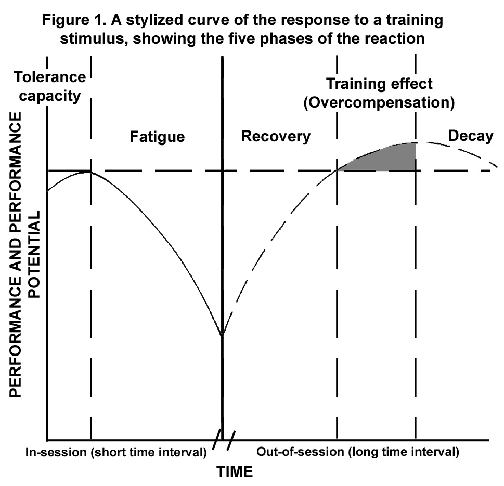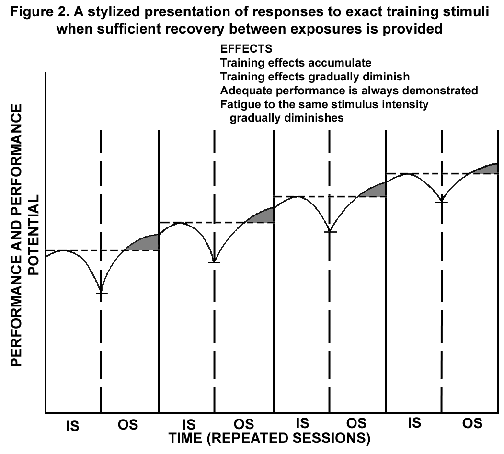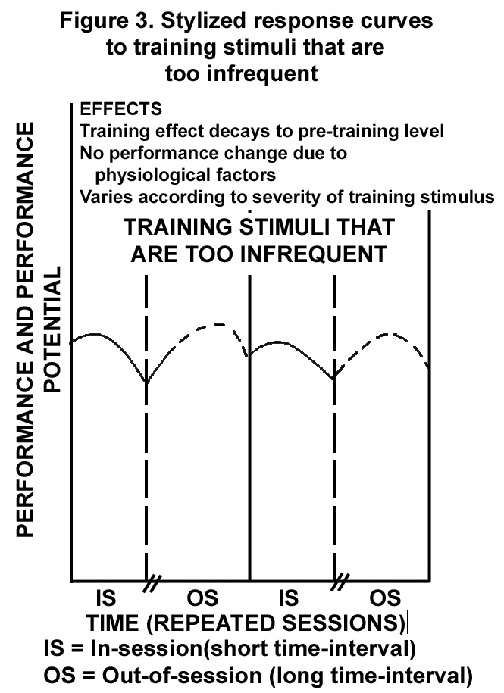

At a recent Carlile coaches' meeting, the opinion was expressed that two sessions per week of race-pace training was an acceptable programming sequence. While it might be acceptable, it most likely will not be optimal. The reasons for this alternate opinion are described below in this issued of the Carlile Coaches' Forum. Much of that which is contained here can be found in the two books, Foundational principles of physical conditioning (Rushall, 2004a), and Programming principles for physical conditioning (Rushall, 2004b). To fully understand the arguments presented, it is necessary to cover principles of modern training theory so that the inclusion of blocked repetitions of race-pace training can be appropriately programmed.
Specific-pace training differs from physical training in that it has to consider both psychological and physiological adaptations. As an energy-limited race progresses, the effort demands of the event gradually increase, although the graduation is much steeper at the end than through the first two-thirds to three-quarters of a race. Swimmers have to learn how to perform at a series of exquisite physiological demands. The control of those demands is what is critical in learning an exact swimming velocity. Thus, race-pace training is more psychological than physiological. It is essentially learning to harness already trained physiological capacities. Psychological considerations are paramount.

The Basic Training Response
Figure 1 illustrates the basic reaction of an athlete to a training stimulus. It produces an overload with regard to the athlete's capacity to perform a particular training segment. Each stage of the response is described below. In race-pace training, a training segment will comprise a block of repeated trials of a task of particular quality dimensions. At other times, a segment might not include blocks of trials, but for race-pace work, it needs to be structured that way.
[Note: The time axis in Figure 1 does not represent consistent duration, the out-of-session section being contracted purely to be accommodated effectively in the picture.]
Tolerance Capacity.
When a training segment is attempted, generally the initial response is one of adequate performance. A swimmer can normally tolerate the demand of a training stimulus that is placed on the body's resources for some time. At the start of the segment, there is usually some warm-up effect and performance quality improves over the standard of the initial attempt. After the early minor improvement, the swimmer tolerates the training stimulus with adequate performance for some time. The major factors that govern the duration of response adequacy are the state of training and the athlete's degree of fatigue. In time, an athlete's resources are taxed beyond their capacities, and performance starts to deteriorate. The onset of that deterioration marks the transition into the next stage of the overall reaction.Fatigue.
When a swimmer can no longer adequately perform the task quality of a training segment, the performance depreciates due to the onset of fatigue. The amount of fatigue that accrues is dependent upon the severity of the training stimulus. While fatigue that prevents race-pace quality is experienced, continued attempts at completing the tasks of a race-pace training segment only produce further performance deteriorations and thus, result in maladaptation and wasted effort. Continued failure to achieve repetition times is psychologically destructive and cannot be justified if sustained. How fatigued a swimmer is or how long this stimulus needs to be tolerated depends upon the aims of training. For race-pace training, the level of fatigue that challenges the swimmer but still allows race-pace quality performances is near the limit of this form of work. It is meaningless to have a swimmer complete a portion of a race-pace training segment successfully and then grind out the remainder of the segment in excessive fatigue and at a slower than desirable pace. Once the training segment or successful portion of the training segment is finished, the next stage of the training response occurs.Recovery.
After a training stimulus ceases, the body attempts to recover by replenishing any energy resources that have been depleted and repairing any physical and neurological damage that has occurred during the segment. The length of time that is spent in the recovery stage is particular to each swimmer but is generally related to the amount of fatigue that has occurred. As a rule-of-thumb, the greater the intensity of the training stimulus, the longer will be the recovery. Recovery involves the re-establishment of the ability of all systems to function fully. It is one of two parts of the response to a training stimulus.Training Effect.
The second part of the reaction to a training stimulus is through the reorganization of the structural and functional systems of the body. This means that if the body was subjected to the same training stimulus again after sufficient recovery and adaptation had occurred, its performance would be different: it would be improved. A common term used to describe this adaptation effect is "overcompensation". The improvement that results from recovery and overcompensation is also called the training effect. It is the purpose of training to produce as many training effects as possible. Effective training allows time for recovery and overcompensation to occur. Once a training effect has been achieved, its longevity is limited. If no further training stimuli are experienced, the training response enters its final stage.Decay.
Due to the temporary nature of a training effect, its lack of use or further stimulation will result in a diminution of performance potential. There will be a return to the pre-stimulus state, that is, the performance level that is normally possible for the individual without specific training.The curve of the response depicted in Figure 1 is largely hypothetical. Real performances do not produce smooth curves of tolerance and fatigue, while the stages of recovery, training effect, and decay indicate only the potential for performance, not real performance. The body's attempt to tolerate the demands of a training stimulus is quite complex, since various resources are mobilized to produce adequate responses. The nature of those, and when and how they are used, governs the response variability during the training segment.
For race-pace training, optimal physiological development will occur when each succeeding race-pace set occurs during the overcompensation phase of the previous set. It is contended that two-times-per-week race-pace training initiates the next training in decay rather than overcompensation. Recovery from particularly demanding training stimuli in the majority of swimmers takes no more than 36 hours. Although they exist as a minority, some take marginally longer. Consequently, initial programs should expose swimmers to race-pace training segments once every 24 to 36 hours, until the volume of velocity-specific work in a segment begins to diminish.
The Training Segment Microcycle
In realistic circumstances, it is impossible to control a swimmer's training response with sufficient precision to guarantee that an ideal training effect will occur through one experience of a training stimulus. For practical purposes, it is usually advisable to repeat the training stimulus in at least three training sessions, assuming that adequate recovery between sessions is provided. As well, there is always the possibility of not gauging the recovery processes correctly. If that occurs, then an athlete may have insufficient time to achieve any training effect and fatigue will accumulate across training sessions. Thus, it is a wise procedure to be conservative in developing training plans by concluding a series of exposures to a training stimulus with a much lighter training stimulus or even a longer-than-normal rest. The final reduction in the intensity of the training stimulus is called the "unloading" phase of the segment microcycle. Active unloading phases in a microcycle are preferred because recovery is accelerated through activity rather than passive rest.
An example for race-pace swimming should further clarify this point. Within a week-long microcycle, three training segments at a particular race-pace demand are planned and concluded with 50% of the segment exposure as the unloading segment. A task might be 30 x 50 meters every 50 seconds at 200-meters race pace. The first exposure occurs on late Monday, followed by late Tuesday, late Thursday, and finally the unloading microcycle of 15 x 50 meters every 50 seconds at 200-meters race pace on Saturday morning. The important feature of this planning is rarely understood by practicing swimming coaches. The demand of the race-pace exposures remains constant throughout the microcycle. It does not change (become more demanding) with each training segment. If it did, then the altered demand would be training different capacities and producing different psychological response patterns in the swimmers to the desired repeated pace performance of the original training segment. No specific training effects would accumulate. If training is planned correctly, a swimmer's response to the third exposure of the race-pace segment should be better than the first, because training effects would have accumulated throughout the microcycle (see discussion below). Swimmers should not become increasingly tired as a microcycle progresses but rather, the reverse should occur. If swimmers perform increasingly worse during a microcycle, there has been insufficient rest and recovery and no facilitation of the development of training effects.
In the next microcycle, the demand of the race-pace training segment should be increased to stimulate the performance of a greater volume of velocity-specific work. Each succeeding microcycle should increase in volume demand, but the number of changes in segment demand is quite limited. For young age-group swimmers, perhaps three weeks of race-pace work is an extreme upper limit. One or two weeks might be better planning and sufficient to promote a notable performance improvement in young swimmers. As swimmers mature, they should be able to tolerate greater volumes of training stress. However, published research, particularly on cyclists, suggests that four weeks of pace-specific training is close to maximum. That length of time is also in concert with the recommendations of coaches who follow periodized training with elite swimmers.
To this point, the discussion has indicated that repetitions of training stimuli within a component microcycle are of the same activity. If this were followed strictly, there is a strong chance that training programs would become very boring for participants. While once boredom in training was not of concern to swimmers, it does seem to be a frequently related problem for today's athletes. Variety in training stimuli appears to be a necessary feature to maintain high levels of motivation in swimmers. Successive presentations of training stimuli within a component microcycle can contain different training items, but the amount and nature of overload should be constant. For example, a swimmer might view the following training items as being equally stressful: eight 200 meters freestyle repeats on 2 minutes 45 seconds, aiming at holding race-pace for the swimmer's best 800 meters time for each repeat, and sixteen 100 meters freestyle repeats on 1 minute 15 seconds, aiming at holding race-pace for the swimmer's best 800 meters time for each repeat. The previous examples might be a form of training most appropriate for an 800 meters race. They would not be appropriate for a 200 meters race because the pace would be too slow. A coach could schedule these different training items as being steps for the same fitness component since they are roughly equivalent in performance level and training load (work intensity, duration, and between repeat recovery opportunity). For some sports, particularly continuous activities such as swimming, running, and cycling, it is relatively easy to develop equivalent load activities that could be used to provide variety in training programs. However, for other activities it is not so easy. When equivalence between training items is determined, the intensity, duration, and recovery opportunities need to be equated. Some experimentation and evaluation of these determinations need to be undertaken to validate their use. For the remainder of this discussion, it is assumed that some training variety will be accommodated in training programs through the use of equivalent training tasks, which can be interchanged to present repeated stimulations of the same overload factor.
Because of the imprecision that is inherent in the practical realities of training, the segment microcycle becomes the building block of all training programs. As a rule-of-thumb, a microcycle consists of at least three exposures to a training stimulus aimed at developing a specific fitness component (e.g., race-pace swimming), each experience being followed by an opportunity for full recovery so that a training effect can be achieved. The segment microcycle is concluded with an unloading training segment of the same performance quality.
Exact Programming
Figure 2 illustrates a response schema for repetitions of an exact training stimulus with sufficient recovery between each exposure in a segment microcycle. It can be seen that the onset of the second exposure to the training stimulus occurs when the maximum training effect (overcompensation) is achieved during the first training response. On successive occasions, the next exposure to the training stimulus also occurs at the time when the training effect is maximized. Repeated exposures in this manner accumulate training effects and the athlete improves in the most efficient manner within the microcycle. Unfortunately, such a perfect program is rarely attainable. However, there are some interesting generalities that can be derived from this exact model.

Over a period of repeated exposures, as the training effects accumulate, a swimmer's internal reorganizations that result from repeated stimulation by a segment of training are successively refined to produce more efficient forms of a particular performance. Each exposure is perceived to be easier than the previous stimulus because the training effects derived from previous experience better equip the athlete to cope with the next segment repetition's demands. Another feature is as repetitions occur; the size of each training effect diminishes. It becomes more difficult to produce noticeable training effects with repeated exposures to a constant training stimulus. A swimmer has limited physical resources with which to respond to training and once those resources are fully used, no further improvement is possible. As a consequence of this finite limitation on adaptation resources, the performance potential of a physiological attribute levels off. Fitness levels may be maintained but not improved. Further improvements in performance will only occur if the intensity of the training stimulus is increased. Successive training load increases are also finitely limited. Under this training segment model of exact programming, optimum performance gains are always possible up to a ceiling limit.
This ideal model allows one to interpret circumstances that frequently arise during attempts to race-pace training adaptations.
Training Stimuli Which Are Too Infrequent
Figure 3 illustrates what happens when training stimuli are sufficient to cause an accumulated training effect. The frequency of their occurrence is insufficient to maintain the temporary training-effect state. Between exposures to the training stimulus, the effect decays back to the pre-exposure level and no performance change occurs.
A stimulus that accompanies a segment of training needs to be of sufficient overload (severity) to cause some fatigue to occur in the swimmer. Repeated exposures to the same stimulus need to occur frequently enough to avoid entering the decay stage of the response, while at the same time allowing sufficient time for recovery and overcompensation. Thus, the timing of exposures to training stimuli and allowing sufficient opportunity to recover and overcompensate is one of the critical decisions that have to be made when developing and administering training programs. The alternation of training loads with recovery is commonly termed "periodization".

Implications for Training Segment Programming
A traditional belief of coaches has been: even though athletes are always tired, training hard, and their performances not changing or even getting worse, good things are still happening to them. THAT IS WRONG. Constant fatigue states do not make a better athlete. Better athletes come from continual improvement derived from experiencing and accumulating training effects. If athletes' performances do not improve, they are not experiencing beneficial training.
Nothing good happens to an athlete when continual catabolic overload-exercise training is experienced. Exercise fatigue only serves to remove an individual from an established homeostatic state. Performance improvements only occur during anabolic recovery/rest when the body reestablishes its homeostasis. One has to get tired to improve but it is not the tiredness/fatigue that leads to change. Physical overload only sets the form and stage for beneficial recovery and training effects. The following are what is known about work and recovery in physical conditioning.
Specific Race-pace Training
General fatigue does not improve performance. All that it allows is the possibility of the performer developing some coping-capacity for performing while non-differentially fatigued. It still requires adequate time for recovery. Specific recovery activities and diet accelerate restoration.
Requirements for Race-pace Performance Improvements
Swimming performances can improve through improvements in movement skills, conditioning, and/or psychological skills. In the context of this discussion, only psychological skills and conditioning are considered.
Race-pace training does not include excessive fatigue. When a swimmer can no longer hold the target race-pace in the training segment, the coach should either terminate participation in the segment or allow the swimmer some unscheduled rest so that the segment can be re-entered and the desired performance level once again displayed. There is no place in a race-pace training segment for any effortful swimming that does not occur at race pace.
References
Return to Table of Contents for Carlile Coaches' Forum.
